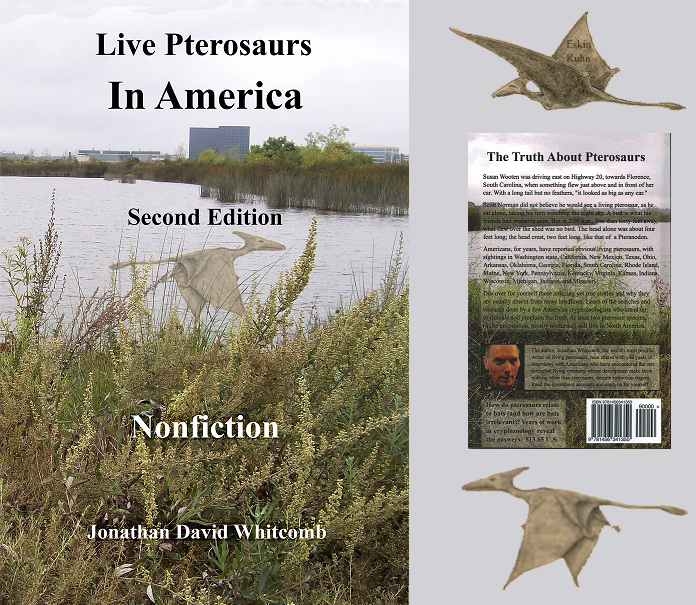Marfa Light Introduction
Specific sightings of mysterious Marfa Lights, in southwest Texas, deserve notice here. Not all sightings of apparently strange lights around Marfa need be from the same source, of course; not all of them need be actually mysterious (I believe that some of them are the bioluminescence of a flying predator: a species of live pterosaur, maybe similar to the glowing ropen of Papua New Guinea). But the strange appearances should receive more attention, for investigating those lights may result in an important discovery.
Marfa Lights and Ropen Lights (blog post by Jonathan Whitcomb)
(ML photographed in 2003) . . . The flying light appeared to have “on and off states as well as occasional bursts to brightness.” He concluded that it had “the appearance of chemical combustion including at least two re-ignitions and step changes in brightness.”
. . . in 2004, the American cryptozoologist David Woetzel witnessed a strange light flying to the mountains near Lake Pung. . . . “shimmering around the edges.” Other eyewitnesses of the horizontally-flying ropen light have mentioned a pulsating appearance.
The Marfa Lights (qsl.net)
Robert Ellison came to Marfa in 1883 . . . He then drove [his cattle] herd . . . and on the second night out, while camped just outside Paisano Pass, he saw strange lights in the distance. . . . Mr. Ellison searched the countryside by horseback. He finally realized that the lights were not man-made. Other early settlers assured him that they too had seen the lights and had never been able to identify them.
Marfa Lights Seen With Binoculars (testimony of the scientific researcher-investigator Ed Hendricks)
Car lights could easily be discerned by their regular motion and color. Other lights would suddenly appear, move slightly, split into multiple lights, and show a distinctly different color and motion. They were not at all head lights.
Handbook of Texas: Marfa Lights
Mrs. W. T. Giddings, who grew up watching the lights and whose father claimed he was saved from a blizzard when the lights led him to the shelter of a cave, considers the lights to be curious observers, investigating things around them.
In recent years the lights have become a tourist attraction. The Texas State Highway Department has constructed a roadside parking area nine miles east of Marfa on U.S. Highway 90 for motorists to view the curious phenomenon. [Marfa Lights Viewing Platform]
Marfa’s Legendary Lights (by Lee Paul) Includes a fuller account of the 1883 sighting and investigation by Robert Ellison (although he seems to have been a cowboy rather than a scientist)
All day, the men searched along the base of the Chinati Mountains and the mesa between their camp and where the lights had been. They found no evidence that Indians had been anywhere in the area. No tracks, no doused campfires, no nothing. But the next night and the next after that, they again saw the strange lights. Cowboys kept seeing the lights night after night, week after week, and year after year. All attempts at identifying them went fruitless. . . . the cowboys finally decided the lights were [not from people] . . . calling them “ghost lights.”
The Marfa Lights — a Mystery (by Rosemary Williams; related by an email from Janet Christian)
“Well, I first saw the Marfa Lights in 1916, when I was teaching school in Presidio,” says Hallie, who has lived in the Big Bend country for most of her 95 years. “Every time I’d go home to Alpine, I’d have to wait until school was out, and it would be nighttime when I would pass by the Chinati Mtns. That’s where the ‘mystery lights’ would appear,” she says.
The Marfa Lights Mystery of Texas (part of report by Zeke_D)
. . . there is a separate and unique light phenomenon in the area of the Chianati mountain range that I can not explain. Balls of light sitting in a chico bush, atop a small pile of rocks or on the foundation of a removed radio antenna spitting streamers and shifting color from yellow to purple and red, a few flashes of yellow streamers and the light blinks out. The lights in the washes and gulleys that you can only see shadows from really get my heart pumping. I want so much to see what they are doing. Normally you just wait and a few will pop out in plain sight. The color changes and lightning like tendrils are very neat to watch. One I really enjoyed watching moved straight up a cliff face and then rested on top of the mountain changing from bright yellow to a dim red then blinked a couple times and was gone.



